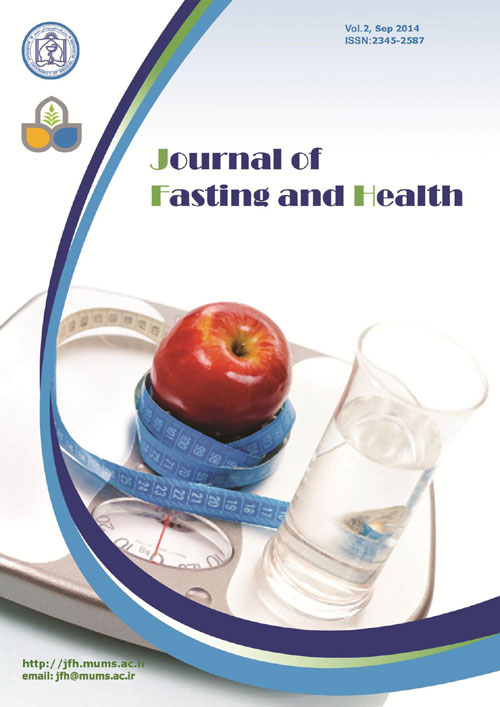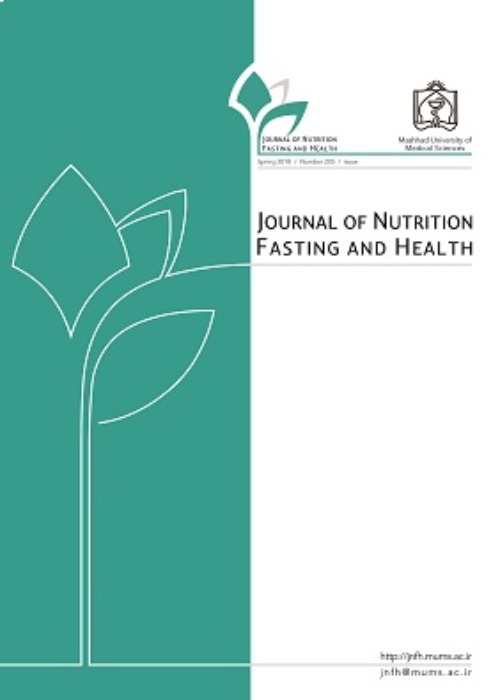فهرست مطالب

Journal of Nutrition, Fasting and Health
Volume:2 Issue: 3, Summer 2014
- 60 صفحه،
- تاریخ انتشار: 1393/10/11
- تعداد عناوین: 8
-
-
Pages 90-95BackgroundWe have previously reported multiple health benefits in individuals following the Christian-based fasting protocol known as the Daniel Fast (DF). However, our prior work has involved only short-term (21-day) assessments. For dietary modification to have a profound impact on health, compliance to the dietary plan must be established for the long-term.Materials And MethodsWe determined the 6-month compliance to a traditional (vegan) DF (n=12), as well as a modified DF (n=9; allowing for the inclusion of small amounts of meat and milk) in healthy individuals. Participants completed diet records during the study period and also rated their overall compliance to the assigned dietary plan.ResultsCompliance to both dietary plans proved to be satisfactory (approximately 80% in the 6th month; 85% in the 3rd month and 95% during the 3rd week). It is noteworthy that it did not show any major differences between groups. Body weight, from baseline toward month 6, saw a decline in participants assigned to both the traditional DF (79.6±5.3 to 75.5±5.5 kg) and the modified DF (80.4±8.0 to 74.3±6.5 kg).ConclusionThese data indicated that both the traditional and modified DF, which involve ad libitum (Latin for “at liberty”) feeding, are realistic for individuals to comply with over a period of several months. Such compliance is associated with a weight loss of approximately 5-8% of the body mass and considering the multi-faceted health benefits of this particular dietary approach, it may result in worthy improvements in overall health. Additional studies of the long-term health implications of this fasting method are also required.Keywords: Fasting, Compliance, Dietary Restriction, Veganism
-
Pages 96-103IntroductionHunger and reduction in regular energy intake can lead to a number of problems based on their intensity. For instance, low energy level can cause blood cell production to decline or it may pose a higher risk of anemia. It can also weaken the immune system and platelet aggregation or negatively affect clot formation. This study aimed to have a closer look at fasting and regular physical activity and their impacts on body composition and blood hematological-biochemical parameters among professional wrestlers.MethodIn this semi-experimental study, 9 subjects were selected by convenience sampling. The selected training program included participation in this exerciseprogram, 90 min per session, 6 times per week for a period of one month. Blood samples were obtained four times: before the start of Ramadan, 2 weeks after the start, during the last week and 2 weeks after the end of Ramadan. To make intra-group comparison, repeated measure analysis of variance was used. For all statistical comparisons, the level of significance was considered at P.ResultsBody weight and red blood cell count (RBC) dropped significantly at the end of Ramadan (Respectively P= 0.001 and P=0.034). However, the number of white blood cells (WBC) and circulating platelets (PLT) significantly increased during fasting (Respectively P= 0.048 and P=0.042). As a matter of fact, PLT and WBC were the only factors which dramatically increased during fasting. Intra-group variations of tetracycline (TC), low-density lipoprotein (LDL), LDL: high-density lipoprotein (HDL), triglyceride (TG): HDL and TC: HDL reduced at the end of Ramadan. However, HDL levels drastically increased during fasting (P≤0.05).ConclusionBased on the results of the research, despite being a regular activity and fasting has beneficial effects on lipid profile in athletes, however, they can with tangible changes in hematological factors may lead to weaken the immune system of athletes.Keywords: Fasting, Regular physical activity, Anthropometric indices, Hematological, Biochemical factors, Elite wrestlers
-
Pages 104-105Warfarin has been the dominant oral anticoagulant since its discovery and first clinical application in the middle of the 20th Century. 1-2 Due to its mechanism of action that reduces the synthesis of active vitamin K-related clotting factors, oral intake of vitamin K rich food has a measurable impact on the anticoagulation effect of warfarin. It is therefore conceivable that periods of food abstinence in the form of fasting has long been suspected of affecting warfarin therapy. 3 In the 1970s, studies using rat models suggested that prolonged fasting increased plasma free fatty acid levels, displacing warfarin from plasma protein. The increased plasma concentration of warfarin led to higher anticoagulation intensity in rats.4-6 It was later demonstrated that a vitamin K deficient state induced by reduced vitamin K intake or fasting led to hypoprothrombinemia, with increased susceptibility in male rats than female rats.7 Despite the compelling results in rat models, the effect of fasting in warfarinized patients was uncertain. There has however been considerable interest in Muslim majority countries on the effect of fasting on patients with chronic disorders during the holy month of Ramadan. Studies have pointed towards significant physiologic and psychological changes in Muslim patients fasting during Ramadan.8-12 A number of studies had indirectly suggested that patients undergoing fasting during Ramadan may experience changes to their anticoagulation therapy. Recently, we reported the findings of a study on the effects of Ramadan fasting on a group of 32 Muslim patients taking warfarin.13 Weekly INR (international normalized ratio) readings were taken from subjects with previously stable INRs over a three-month period spanning pre-Ramadan to post-Ramadan. We found a statistically significant increase in the mean INR by 0.23 (p=0.006) during Ramadan from the pre-Ramadan month and decreased by 0.28 (p<0.001) after Ramadan. There was no significant difference (p=1.000) in mean INR between the non-Ramadan months. Importantly, there was a decline in the time within therapeutic range (TTR) during Ramadan with a corresponding increase in TTR above the therapeutic target range. %TTR declined from 80.99% before Ramadan to 69.56% during Ramadan (p=0.453). The first out-of-range INR was seen around 12.1 days (95% CI 9.0-15.1) after the start of fasting and returned within range about 10.8 days (95% CI 7.9-13.7) after Ramadan. Time above range increased from 10.80% pre-Ramadan to 29.87% during Ramadan (p=0.027), while time below range increased from 0.57% during Ramadan to 15.49% post-Ramadan (p=0.006). This observation is directly attributable to the effects of fasting. To conclude, warfarin may increase the INR of patients during religious fasting. This is inconsequential in the majority of fasting patients. However, among patients with labile INRs or at higher risk of bleeding, the potential harm of a higher INR should mandate more frequent monitoring or pre-emptive titration during periods of fasting.
-
Pages 106-108Children, similar to adults, are required to fast before general anesthesia in order to reduce the volume and acidity of stomach contents. It is thought that NPO regulations reduce the risk of regurgitation and aspiration of gastric contents during surgery. Recent developments have encouraged a shift from the standard 'nil by mouth from midnight' fasting policy to more relaxed regimens. Preoperative NPO status for each patient must be regulated according to his/her age and timing of the surgery, the night before the operation (2 hours for clear fluids and 4-6 hours for solid foods and milk before the surgery, considering his/her age).Keywords: Children, General Anesthesia, Preoperative fasting
-
Pages 110-112Total abstention from food and water from sunrise to sunset during the month of Ramadan, is practiced by hundreds of millions of Muslims throughout the world. This pattern of fasting during Ramadan is different from the usual fasting as people are allowed to eat and drink between sunset and dawn but not after dawn. The amount and type of food (rich in protein, fat and sugar) eaten during the night may also be significantly different to that usually consumed during the rest of the year, while in other countries factors such as poverty ensure that the Ramadan fast results in a reduction in energy intake and a loss of body fat. Also, climate and duration of fasting differs from region to another. According to Islam, sick people are exempted from Fasting, but still a significant number of patients with various chronic diseases including chronic kidney diseases (CKD) insist on fasting in Ramadan due to their personal beliefs and physicians are facing this problem every year: What to advice their patients as there are no guidelines or protocols about who can and who cannot fast. In general no detrimental effects on health have been directly attributed to fasting during Ramadan. However caution is advised for moderate to severe CKD patients and the physicians should monitor their patients carefully during Ramadan in order to avoid any deleterious effects.Keywords: Dehydration, Electrolytes, Fasting, Kidney function, Osmolality, Ramadan, Renal physiology, Stones, Uric Acid
-
Pages 113-118Fasting does have remarkable benefits in the treatment of cancer and another diseases such as metabolic syndrome, diabetes, and a multitude of other chronic diseases. It has been determined that fasting could play an important role during cancer treatment and progression via the regulation of insulin-like growth factor-1 (IGF-1) as well as other growth factors. Also, it has been shown that fasting would enhance the chemotherapy effect in cancer patients, selectively protects normal cells and organisms from chemotherapy toxicity, while simultaneously sensitizing tumors. In this article, we discuss the benefits of fasting in the treatment of cancer through several different molecular pathways.Keywords: Cancer treatment, emotherapy toxicity, Fasting, Insulin, like growth factor, 1
-
Pages 119-130Although several studies have investigated the effects of Ramadan fasting on diabetic patients, the exact impacts on diabetes control have not been well elucidated yet. There are neither precise quantitative criteria nor clear guidelines regarding Ramadan fasting for diabetic patients. This review aimed to discuss the results of previous studies. The neglected points in performed studies should be considered in the design and interpretation of future research related to Ramadan fasting in diabetic patients. A thorough research was carried out on the internet, using the following keywords: “Ramadan”, “Ramadan fasting”, “Islamic fasting”, “fasting in Ramadan”, and “fasting”, in combination with words such as “diabetes mellitus”, “hyperglycemia”, “hypoglycemia”, and “diabetic ketoacidosis”. Databases including PubMed, Google Scholar, and some regional databases were searched in order to find related articles (cross-sectional, descriptive-analytical, cohort, clinical trial, and review studies), published during 1957-2013. The obtained data showed that Ramadan fasting could be non-risky for partially controlled diabetic patients. However, the safety of Ramadan fasting for diabetic patients with different blood glucose levels and complications is not yet determined. Many deficiencies and limitations are observed in the related studies such as the heterogeneity of participants including differences in lifestyle and circadian rhythm changes. Therefore, well controlled studies need to be performed to evaluate factors affecting blood glucose level during Ramadan fasting.Keywords: Ramadan fasting, Diabetes mellitus, Hyperglycemia, hypoglycemia


